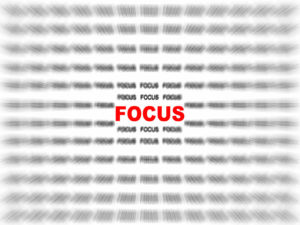
A Demonstration on Nearsightedness
When we start noticing vision changes, especially drastic changes, it’s a pretty common response to head to the eye doctor to see what’s up. One of the most common problems people seek help for is blurry vision. Understanding the causes behind blurry vision is key to getting proper treatment. And, one of the most common causes of blurry vision is myopia, or nearsightedness. But what is it like to be nearsighted? This demonstration on nearsightedness may help you determine what’s up with your vision.
Nearsightedness Demonstration
There are some simple ways to explain it, but isn’t it better to see a live demonstration on how nearsightedness affects vision? We’ve found a video that clearly explains what it’s like to experience blurry vision from nearsightedness, also known as myopia.
In this nearsightedness demonstration, you’re shown what it’s like to drive a car with myopia. Street signs become blurry and you must rely on colors and shapes. You might find yourself squinting to see the signs better. Clearly, this is a dangerous way to drive. If you relate to this video, it’s time to book an eye exam.
The doctor will tell you that glasses are the simple fix to the problem of nearsightedness, but the quick fix isn’t always the best fix. Many of us do not want to spend the rest of our lives wearing glasses. This usually translates to a new pair of glasses every year or two for the rest of our lives. That’s not only vision limiting and hindering, but costly. Your doctor may even suggest wearing contact lenses. But, this solution comes with its own risks and challenges.
The video doesn’t really offer any solutions besides seeing your doctor. We’re here to say there are natural methods to help fix the vision problem.
The Truth about Myopia
Why do some people develop myopia while others don’t? There are several reasons people develop myopia. It can develop from eye fatigue, body growth, or heredity. Obviously, we can’t change our family’s medical history or the conditions we’re predisposed to have. But if the cause of your myopia is environmental or situational, there are things you can do to prevent it. Even if you are predisposed to myopia, there are steps you can take to decrease your chances of developing it.
Rest Your Eyes
As much as we need to strengthen our eyes, we also need to rest them. Eyestrain from overuse is detrimental to eye health. When working at a computer for a long period of time, take frequent breaks to give your eyes the rest they need. Another good way to let your eyes relax is to rapidly rub the palms of your hands together, then place the palms of your hands over your closed eyes. This exercise is called palming and it creates a very relaxing and soothing feeling.
Stretch Your Eyes’ Muscles
What happens to your knees if you keep them bent in the same position for hours? They get stiff and sore. The same thing can happen to the muscles that control your eyes. Many of us use a computer for work or school. We might spend eight hours a day staring straight ahead, keeping our eyes in the same position. Over time, this behavior can deter your distance vision and lead to myopia.
Consider adding eye yoga to your daily routine. In the morning, at lunch, and before bed, stretch your eyes. Practice rolling them from left to right, up and down. Do eye circles in both directions. Then, stare at objects in varying distances from you. To do this, either go outside or stare out your window. Doing eye exercises like these will give your eyes’ muscles a chance to stretch. Flexible eye muscles allow your eyes to adjust to seeing objects up close and far away without blurriness.
Diet and Vision
It can be said that the first step to improving poor vision is a healthy diet. So, you can address nearsightedness without resorting to glasses by improving your eating habits. There are some foods that are better for your eyes than others. If you want to reduce the risk of or improve nearsightedness, eat a nutrient-rich diet. Some of the nutrients you should be focusing on are vitamin C, vitamin D, calcium, selenium, magnesium and chromium.
Vitamin C helps keep the tissue of the cornea healthy and it helps maintain the health of the blood vessels which carry nutrients and oxygen to the retina. To get more vitamin C in your diet, try to add foods like citrus fruits, tomatoes, strawberries, peppers, and broccoli.
Vitamin D is also important to the cornea because it enhances corneal epithelial barrier function. Studies have also found that people who suffer from myopia also have a lower-than-average level of vitamin D in their blood. Try adding liver, tuna, eggs, and fortified drinks like milk or orange juice to get more vitamin D in your diet.
Calcium can be added to your diet by consuming more yogurt, milk, or cottage cheese. Magnesium can be added to foods like spinach, peanuts, almonds, cashews, avocados, and beans. Foods such as salmon, halibut, sardines, tuna, shrimp, and eggs are all good for adding selenium to your body. Chromium can be added by eating tomatoes and onions.
Unsure of the most important vitamins and minerals for not just myopia, but overall great vision health? Look at this list of 17 essential herbs, vitamins and minerals. If you think that it’s too difficult to get all the necessary nutrients in your diet on a regular basis, then a supplement might be the right choice for you.
Seeking Help
We hope this demonstration on nearsightedness helped a bit. If you are experiencing symptoms of myopia, you should have an eye examination to determine what the underlying issue is. The symptoms of myopia include headaches, squinting, eye fatigue, rubbing the eyes, blurry vision, and eyestrain. A doctor may recommend that you correct your vision with lenses. But, remember that you may be able to rebuild your vision with the correct diet and eye exercise program. Myopia can be beaten!
Our Rebuild Your Vision Ocu-Plus Formula Contains All 17 Vitamins, Minerals, and Herbal Supplements to Improve Your Eye Health!












Good question Cathy I’d like to know too. My belief is that with regular eye exercises the shape of your eye will eventually change, just like any other muscle in our body changes its shape when exercised.
After a growth spurt do you need new glasses?
Hi,
My daughter has really poor vision (myopia) plus astigmatism. She says her vision is so bad that she can’t even see the features on someone’s face standing just a couple feet in front of her. Granted, she inherited some bad eye genes, since her eyes started getting bad at about age 6. She started out wearing glasses, but in her teens she began wearing contacts and still does. She wants to get Lasik surgery, but this concerns me greatly. I told her about eye exercises. Do you think there is any hope of her eyesight improving even though she is 30 yrs old now? At least even improving it! For myself, my eyes have always been bad (myopia) since the age of 3-5 yrs old and started wearing glasses. Now that I’m in my 50’s and I have to wear progressive Rx glasses, (I hate them btw!) I noticed I still have to take them off to read because they still suck at helping me completely. So, I just take them off to read. But then I have to put them on to see faraway! So now, I have been leaving my glasses off a lot more lately and have noticed that my vision doesn’t seem as bad as when I wear my glasses a lot and then take them off for awhile. Granted, I can’t see details for the fuzziness, but it seems my eyes get a little better the longer I leave them off. But…there is a fine line there, because if I leave them off too long (like all day) I start to get eye strain. So, I’m thinking that maybe leaving my glasses off as much as possible, might be forcing my eyes to work more to adjust my vision. I don’t know, what do you think? Am I doing more harm than good doing that? I’m thinking it’s kind of like when you put your crutches down and start trying to make the muscles in your legs have a workout to strengthen them. Afterall, you wouldn’t want to be on crutches forever. My question is, can someone at my age still reshape their eyeball through exercising the eye muscles or is the shape of the eyeball after your grown, permanent? In otherwords, can strengthening the muscles in your eyes actually change the shape of your eyeball or does it just strengthen the muscles so they can compensate for the misshapen eyeball? And, what about astigmatism, can that be corrected through non-surgical means? Have you had any positive response (feedback) that you can send my way of people who’s eyes were really bad and then improved doing what you suggest? I think I am going to have to do a lot of convincing to my daughter before she is willing to try exercises, although it makes total sense to me.
Hi Kathy I am Jim from Hamilton Ohio. I had myopia since I was 7 years old. I was adopted when I was 2 months old. When I tried another students glasses on I could see better. I told my parents about this and they wouldn’t believe me. So they said they would take me to an eye doctor and if I wasn’t being truthful I’d be in trouble. Well the doctor said I did need glasses. They were surprised when he told them that and the appoligised to me. Well my eyes have really got a lot worse than that as I am 59 years old. My vision is so bad without glasses on I can’t ever see things 1foot away from me eyes. But with glasses I can’t see things close up at all. Plus in 1973 I had a car accident which messed up my vision worse and my vision got about 2x as bad after getting out ou the hospital. I don’t know if my eyesight will get better but I’d like to know